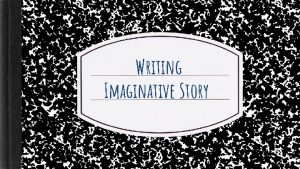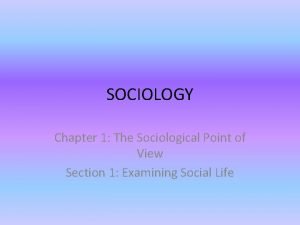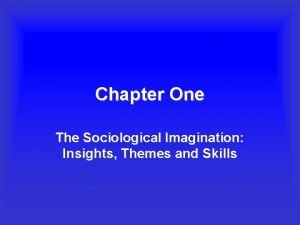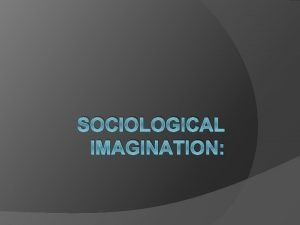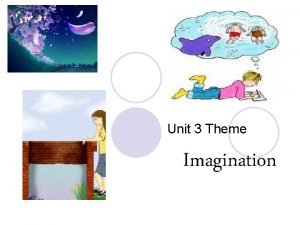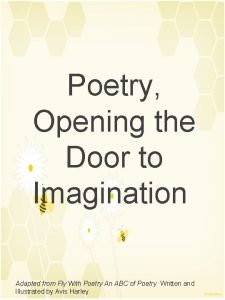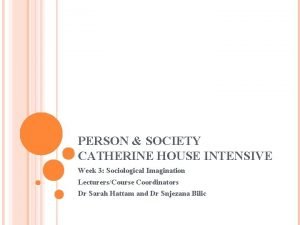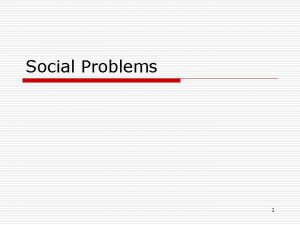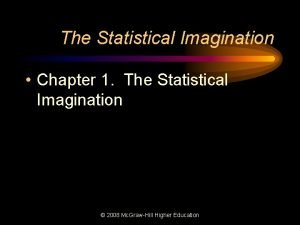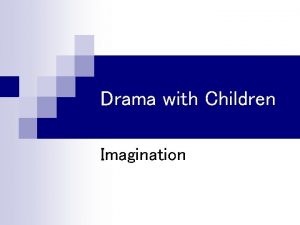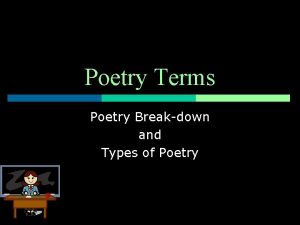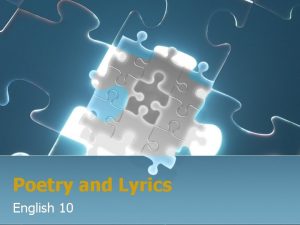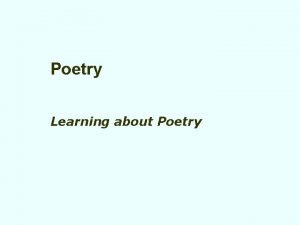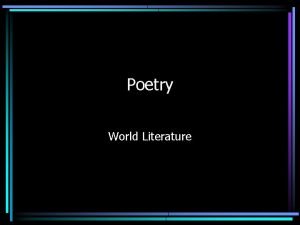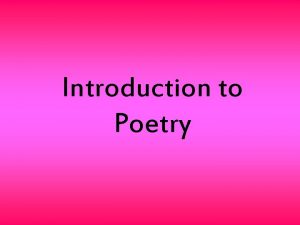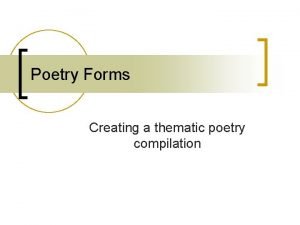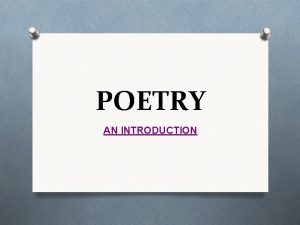Read Poetry And Open Your Imagination 4 th































- Slides: 31

Read Poetry And Open Your Imagination 4 th Grade Communication Arts Created by Julie Pettyjohn

By the end of this interactive presentation, you will be familiar with six forms of poetry and be ready to write two of your own poems as a class assignment. This exercise builds toward GLE Reading: 2. Develop and apply skills and strategies to comprehend and evaluate fiction, poetry, and drama from a variety of cultures and times. Level Grade 4: Recognize the text features of fiction, poetry, and drama in grade-level context.

Directions n n n Go Back On the main menu (next slide), find six forms of poetry. Start with any one you like, but return to the main menu after each section until you have completed all six. Take the quiz after you have read all six sections. After the quiz, advance to the Summary and open the Word document to do your writing assignment. Directions Main Menu Sources Take Quiz Next

Sources n n n n http : //teacher. net http: //www. ahapoetry. com/haiku. htm#issa http: //www. pbskids. org http: //www. toyomasu. com/haiku International Reading Association. http: //www. readwritethink. org/lessons/lesson_view. asp? id=43 Knock at a Star: A Child’s Introduction to Poetry, X. J. Kennedy and Dorothy M. Kennedy Los Angeles County Office of Education. http: //teams. lacoe. edu Where the Sidewalk Ends by Shel Silverstein

Main Menu – Poetry Palace Lyric Haiku Limerick Cinquain Narrative Free Verse

Narrative Poems A narrative poem tells a story. n Sometimes the lines rhyme. Sometimes they do not rhyme. n

Example: Narrative The Purist I give you now Professor Twist, A conscientious scientist. Trustees exclaimed, “He never bungles!” And sent him off to distant jungles. Camped on a tropic riverside, One day he missed his loving bride. She had, the guide informed him later, Been eaten by an alligator. Professor Twist could not but smile. “You mean, ” he said, “a crocodile. ” by Ogden Nash

Limerick Poems Limericks are usually funny or silly. n They have a rhythm or beat and a rhyming pattern. n

Example: Limerick Ickle Me, Pickle Me, Tickle Me Too (Here is one stanza, not the entire poem. ) Ickle Me, Pickle Me, Tickle Me too Went for a ride in a flying shoe. “Hooray!” “What fun!” It’s time we flew!” Said Icke Me, Pickle Me, Tickle Me too. by Shel Silverstein

Free Verse Poems Free verse poems have no real rhythm or pattern. n Sometimes the author places the words of the poem on the page in a pattern to reflect the subject. n Let your imagination soar when you write a free-verse poem. n

Example: Free Verse For a Quick Exit For going up or coming down, In big department stores in town. you take an escalator. (They come in pairs. ) Or else an elevator. (Also stairs. ) I wish storekeepers would provide a s l i d e ! by Norma Farber

Haiku Poems n n Haiku poetry began in Japan. A haiku has three short lines. Traditional Japanese Haiku had five syllables on line 1, seven syllables on line 2, and five on line 3. This rule is not usually followed in English. To write a Haiku, think of a subject and write thoughts, not sentences.

Examples: Haiku Poverty’s child – he starts to grind the rice, and gazes at the moon. by Basho, Matsuo Now the swing is still, a suspended tire centers the autumn moon. by Nicholas Virgilio

Lyrics Lyric poems express feelings and emotion. n Lyrics put with music are songs. n

Example: Lyric Blowin’ in the Wind How many roads must a man walk down before you call him a man? Yes, ‘n’ how many seas must a white dove sail before she sleeps in the sand? Yes, ‘n’ how many times must the cannon balls fly before they’re forever banned? The answer, my friend, is blown’ in the wind. The answer is blowin’ in the wind. by Bob Dylan

Cinquain Poems n n n There are exactly five lines (from the French word “cinq, ” which means five) Line 1: 1 word (subject of the poem) Line 2: 2 words (adjectives that describe line 1) Line 3: 3 words (action verbs relating to line 1) Line 4: 4 words (feelings or a complete sentence) Line 5: 1 word (that sums up line or is a synonym of line one)

Examples: Cinquain Triangles pointy, edged revolving, rotating, angling Triangles are all different. 180 Anonymous Students boy, girl playing, studying, growing I like my students. achievers by Mrs. Pettyjohn Keyboard fun, new reading, laughing, writing You have new messages. E-mail Anonymous

Are you ready to take a short quiz? Yes I am ready to begin No I’ll go back to the Main Menu and review some more.

Question 1 Read the poem and select the form of poetry that best represents the style in which it is written. That Lovable Old Issa by Earle Joshua Stone Free verse Come over with me and together let’s play Oh, motherless sparrow. Haiku Cinquain Lyric

Correct! Way to go!

Oops! Try again

Question 2 Read a selection from the poem, “Paul Bunyan” and select the form of poetry that best represents the style in which it is written. Paul Bunyan by Shel Silverstein He rode through the woods on a big blue ox. He had fists as hard as choppin’ blocks, Five hundred pounds and nine feet tall … that’s Paul. Talk about workin’, when he swung his axe You could hear it ring for a mile and a half. Then he’d yell, “Timber!” and down she’d fall … for Paul. Free verse Cinquain Lyric Narrative

Correct! Go to question 3

Oops! Try question 2 again

Question 3 Read the poem below and select the form of poetry that best represents the style in which it is written. Oops by Shel Silverstein Down Found Upside I Out Can’t Come But All Try Poems Do My I Free verse Haiku Around All Them Turn Not Can I Cinquain Down Upside Out Come All Poems My Narrative

Correct! Go to question 4!

Oops! Try question 3 again

Question 4 Read the poem and select the form of poetry that best represents the style in which it is written. Magic by Shel Silverstein Sandra’s seen a leprechaun, Eddie touched a troll, Laurie danced with witches once, Charlie found some goblins’ gold. Donald heard a mermaid sing, Susie spied an elf, But all the magic I have known, I’ve had to make myself. Free verse Narrative Limerick Lyric

Correct! You completed the quiz!

Oops! Try question 4 again

Summary n n You are now familiar with six different forms of poetry. – A narrative poem tells a story – Limericks are funny or goofy – Haiku is a three-line form of poetry from Japan – Free verse has no rules and is creative – Cinquains are poems with five lines that follow a word number pattern – You can sing lyrics Now, you are ready to write a few poems. Click on the Word icon and write one Haiku poem and one Cinquain. – Put your name on the page – Print your assignment and turn in the printed page
 Imaginative writing
Imaginative writing Exercise your imagination
Exercise your imagination Open innovation open science open to the world
Open innovation open science open to the world With lots of imagination and new ideas
With lots of imagination and new ideas Open your eyes free your mind
Open your eyes free your mind By adopting a sociological imagination
By adopting a sociological imagination Pitt reddemann
Pitt reddemann Destination imagination 2001
Destination imagination 2001 Empowering imagination
Empowering imagination The sociological imagination chapter 1 summary
The sociological imagination chapter 1 summary Lucid imagination
Lucid imagination Imagination development
Imagination development Sociological imagination abortion
Sociological imagination abortion Lucid imagination
Lucid imagination Sociological imagination examples race
Sociological imagination examples race Youtube sociological imagination
Youtube sociological imagination Destination imagination 2001
Destination imagination 2001 Sociological imagination vs sociological perspective
Sociological imagination vs sociological perspective Through grandpa's eyes questions and answers
Through grandpa's eyes questions and answers Maxine greene releasing the imagination
Maxine greene releasing the imagination The man with no imagination has no wings
The man with no imagination has no wings Sociological.imagination
Sociological.imagination Betty botter bought a bit of butter
Betty botter bought a bit of butter Individual agency
Individual agency Imagination is greater than knowledge
Imagination is greater than knowledge Imagination farms
Imagination farms Problems with conflict theory
Problems with conflict theory Empowering imagination
Empowering imagination General electric imagination at work
General electric imagination at work Narrative poems by shel silverstein
Narrative poems by shel silverstein Give us your hungry your tired your poor
Give us your hungry your tired your poor Which two statements about narrative nonfiction are true?
Which two statements about narrative nonfiction are true?
